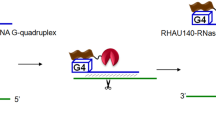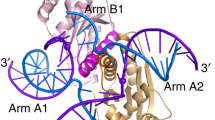Abstract
A novel mechanism of DNA endonucleolytic cleavage has been visualized for the homing endonuclease I-PpoI by trapping the uncleaved enzyme–substrate complex and comparing it to the previously visualized product complex. This enzyme employs a unique single metal mechanism. A magnesium ion is coordinated by an asparagine residue and two DNA oxygen atoms and stabilizes the phosphoanion transition state and the 3'oxygen leaving group. A hydrolytic water molecule is activated by a histidine residue for an in-line attack on the scissile phosphate. A strained enzyme–substrate–metal complex is formed before cleavage, then relaxed during the reaction.
This is a preview of subscription content, access via your institution
Access options
Subscribe to this journal
Receive 12 print issues and online access
$189.00 per year
only $15.75 per issue
Buy this article
- Purchase on Springer Link
- Instant access to full article PDF
Prices may be subject to local taxes which are calculated during checkout




Similar content being viewed by others
References
Pingoud, A. & Jeltsch, A. Eur. J. Biochem. 246, 1–22 (1997).
Jurica, M.S. & Stoddard, B.L. Cellular and Molecular Life Sciences 55, 1304–1326 (1999).
Aggarwal, A.K. & Wah, D.A. Curr. Opin. Struct. Biol. 8, 19–25 (1998).
Belfort, M. & Roberts, R.J. Nucleic Acids Res. 25, 3379–3388 (1997).
Belfort, M. & Perlman, P.S. J. Biol. Chem. 270, 30237–30240 (1995).
Belfort, M., Reaban, M.E., Coetzee, T. & Dalgaard, J.Z. J. Bacteriol. 177, 3897–3903 (1995).
Pietrokovki, S. Protein Sci. 63, 64–71 (1998).
Dalgaard, J.Z. et al. Nucleic Acids Res. 25, 4626–4638 (1997).
Silva, G.H., Dalgaard, J.Z., Belfort, M. & Roey, P.V. J. Mol. Biol. 286, 1123–1136 (1999).
Heath, P.J., Stephens, K.M., Monnat, R.J. & Stoddard, B.L. Nature Struct. Biol. 4, 468–476 (1997).
Duan, X., Gimble, F.S. & Quiocho, F.A. Cell 89, 555–564 (1997).
Jurica, M.S., Monnat, R.J. & Stoddard, B.L. Mol. Cell 2, 469–476 (1998).
Muscarella, D.E. & Vogt, V.M. Cell 56, 443–454 (1989).
Muscarella, D.E., Ellison, E.L., Ruoff, B.M. & Vogt, V.M. Mol. Cell. Biol. 10, 3386–3396 (1990).
Lowery, R., Hung, L., Knoche, K. & Bandziulis, R. Promega Notes 38, 8–12 (1992).
Whittmayer, P.K. & Raines, R.T. Biochemistry 35, 1076–1083 (1996).
Ellison, E.L. & Vogt, V.M. Mol. Cell. Biol. 13, 7531–7539 (1993).
Flick, K.E., Jurica, M.S., Monnat, R.J. & Stoddard, B.L. Nature 394, 96–101 (1998).
Miller, M.D., Tanner, J., Alpaugh, M., Benedik, M.J. & Krause, K.L. Nature Struct. Biol. 1, 461–468 (1994).
Friedhoff, P. et al. Nucleic Acids Res. 24, 2632–2639 (1996).
Friedhoff, P. et al. Nature Struct. Biol. 6, 112 (1999).
Miller, M.D., Cai, J. & Krause, K.L. J. Mol. Biol. 288, 975–987 (1999).
Friedhoff, P., Franke, I., Krause, K.L. & Pingoud, A. FEBS Lett. 443, 209–214 (1999).
Cotton, F.A. & Wilkinson, G. in Advanced inorganic chemistry 253–270 (John Wiley and Sons, New York; 1980).
Baldwin, G.S., Sessions, R.B., Erskine, S.G. & Halford, S.E. J. Mol. Biol. 288, 87–103 (1999).
Flick, K.E. et al. Protein Sci. 6, 2677–2680 (1997).
Otwinowski, Z. & Minor, W. Methods Enzymol. 276, 307–326 (1997).
Brünger, A. X-PLOR: a system for X-ray crystallography and NMR. (Yale University Press, New Haven, Connecticut; 1992).
Brünger, A. Acta Crystallogr. D 49, 24–36 (1993).
Author information
Authors and Affiliations
Corresponding author
Rights and permissions
About this article
Cite this article
Galburt, E., Chevalier, B., Tang, W. et al. A novel endonuclease mechanism directly visualized for I-PpoI. Nat Struct Mol Biol 6, 1096–1099 (1999). https://doi.org/10.1038/70027
Received:
Accepted:
Issue Date:
DOI: https://doi.org/10.1038/70027
This article is cited by
-
Phosphodiester hydrolysis computed for cluster models of enzymatic active sites
Theoretical Chemistry Accounts (2016)
-
Homing endonucleases from mobile group I introns: discovery to genome engineering
Mobile DNA (2014)
-
Homing endonucleases: from basics to therapeutic applications
Cellular and Molecular Life Sciences (2010)
-
Mutagenesis identifies the critical amino acid residues of human endonuclease G involved in catalysis, magnesium coordination, and substrate specificity
Journal of Biomedical Science (2009)
-
An equivalent metal ion in one- and two-metal-ion catalysis
Nature Structural & Molecular Biology (2008)



